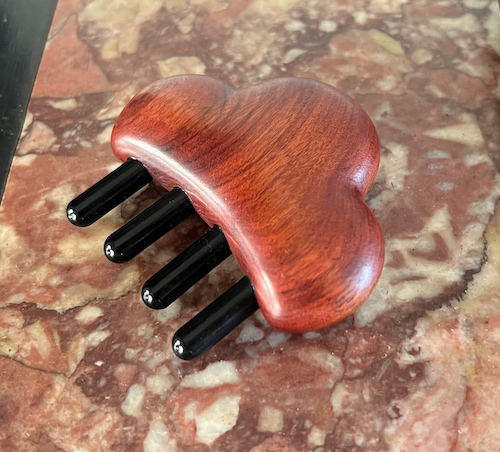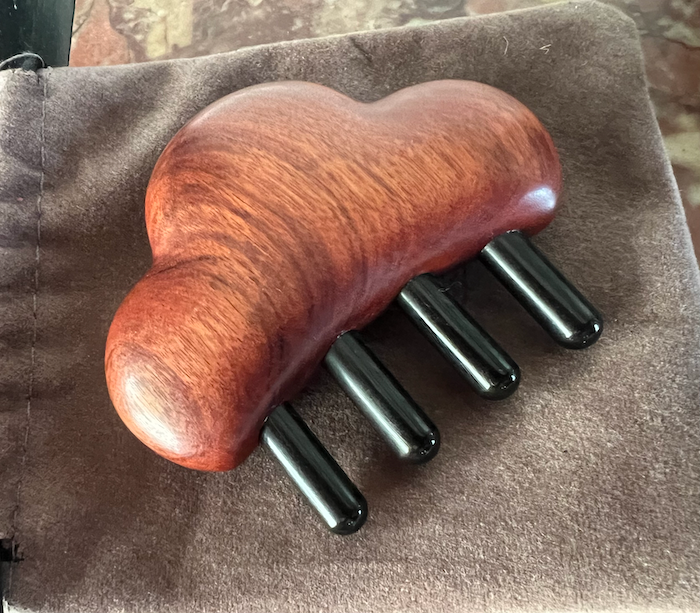
Spring Wellness: Ox Horn Gua Sha the Liver, Gallbladder, and Spleen Meridians
Spring is the season associated with the liver and the gallbladder organ systems, and so it is a great time to work this daily yangsheng practice into your routine.
In the Huangdi Neijing (黄帝内经) it says that the liver is the “general of the human body” (人体的将军), tasked with leading an army to resist toxins that are accumulating within and invading from without. The liver is responsible for maintaining the smooth flow of qi and blood. A variety of problems including poor quality of sleep, waking up in the middle of the night every night (usually between 1-3am), emotional imbalance, procrastination, and irregular menstruation in women are all common signs of stagnation in the liver system.
The liver and gallbladder meridians form a yin-yang pair and have a special connection with the body’s tendon/sinew/connective tissue system. The connective tissue system itself also forms a yin-yang pair with the body’s meridian system, and so maintaining it is of course important both for general health and for assisting progress in neigong practice. By working these meridian lines along our legs with a gua sha tool such as an ox horn scraper (牛角刮痧板), we can smooth out the tissues associated with these meridians, and create that smooth and slippery state that is desirable for our fascia, working out any gummy and crinkly fascial adhesions while also improving the circulation of blood and qi. While working the inside of the leg, it is natural to also work on the spleen meridian which is in the same general area and also an important meridian system to nourish in the spring season.

To perform this technique we will work on the segments of the liver and gallbladder meridians on the legs. I like to use an ox horn scraper, but other gua sha tools can be used instead.
This is not something that you do once and forget about, it is something that you need to work into your daily routine as it will bring positive results when you are consistent over time. It is probably ideal to set aside 10-30 minutes where you just focus on this and nothing else, or even have someone else perform this on you so that you can lie down and relax during the process, but we are all busy and so sometimes we have to make certain concessions. I often do this while I watch a show or do something similar in the evening to wind down. While it is probably ideal to not have your attention absorbed into something while doing this, if I didn’t work it into my evening routine in this way I likely wouldn’t end up being very consistent with it. You’ll want to work each leg for about 15-20 minutes, or at the very least get in 20-30 or so good strokes on each segment.
First, it is important to note that we start with the yang side of the body (left leg) and the yang side of the leg (outside). So you will proceed in the following order:
- Outside of left leg (gallbladder meridian)
- Inside of left leg (liver and spleen meridian)
- Outside of right leg (gallbladder meridian)
- Inside of right leg (liver and spleen meridian)
Apply some lubrication to the gua sha tool and to your leg (I use massage oil) so that the tool glides easily across your skin.
Begin working by stroking with the tool along the outside of the thigh from just above the top of the leg (gallbladder 30, on the side of the buttocks) towards the knee. Use as much pressure as is relatively comfortable, but note that there may be some discomfort, especially if there is stagnation in the meridians (just don’t bear down so hard that you cause injury). Be sure to be careful and go lightly around the joints, such as the knee, and in places where there is more bone than muscle.

I like to work the thigh for several strokes, occasionally doing a full stroke along the full length of the of the leg, and then do a few on the foot. I will then proceed to move the focus more toward the portion of the leg below the knee (again occasionally doing a full stroke along the whole length of the leg). I do the same process for the inside of the leg after doing the outside. While it is a good idea to review where the meridian lines run, you don’t have to be too precise and can just work the general areas. Also note that it is fine to just stroke from top to bottom as that is usually easiest (you don’t necessarily have to stroke in the direction of the meridian). However, it is recommended for people who have a lot of varicose veins on the legs or edema to stroke from the bottom up. It is also just generally recommended to be careful and go very lightly over varicose veins.
During or after gua sha it is a convenient time to incorporate some massage on certain key acupoints on the legs using either the gua sha tool or your finger.

The following are some points that you might consider:
Xue Hai “See of Blood” Acupoint 血海穴 (SP 10): If you flex your quads you should be able to feel this area bulge on the inner thigh slightly above the knee. This is on the spleen meridian and massaging it can aid the spleen in the transport of blood, as well as dispel blood stasis, and harmonize menstruation in women.

Zusanli 足三里 (ST 36): This is a commonly used acupoint. Sometimes called the “point of one hundred diseases,” or “point of longevity.” It can eliminate fatigue and strengthen the body, tonify qi, blood, and jinye (body fuilds), dispel dampness and wind, and harmonize the spleen and stomach.

Sanyin Jiao 三阴交 (SP 6): Tonifies the spleen, stomach, and kidneys; resolves dampness, calms the spirit, harmonizes the liver and smooths the flow of qi.

Xuan Zhong 悬钟 (GB 39): Soothes the liver and gallbladder, replenishes the kidneys and marrow, clears gallbladder fire, good for the bones and sinews.

Tai Zhong 太沖 (LR 3): calms liver yang and soothes liver fire, spreads liver qi and resolves liver qi stagnation, regulates circulation of qi and liver blood, regulates the lower jiao, clears wind.


